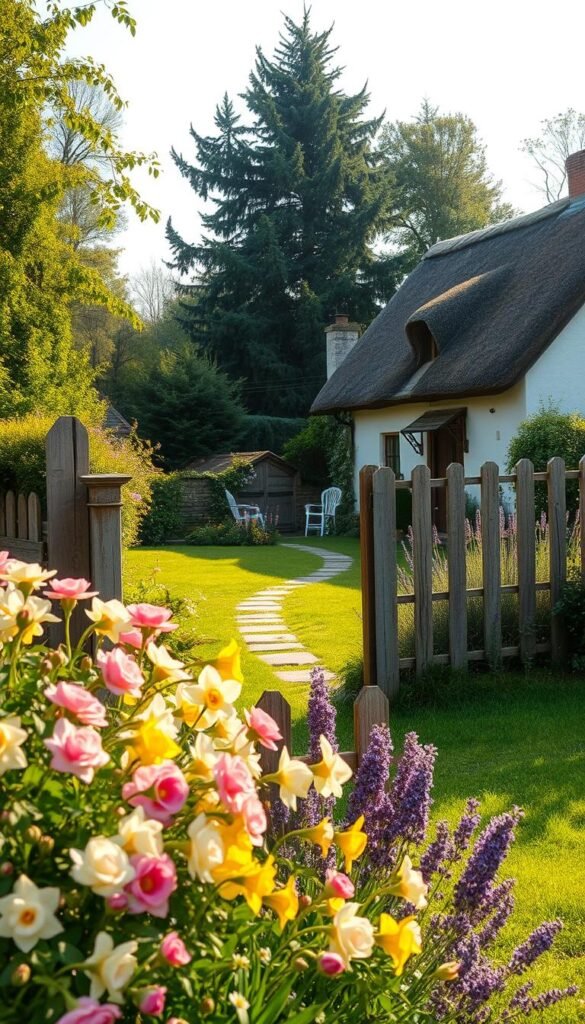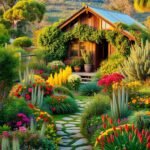Imagine stepping into a space where history and nature dance together. The roots of this beloved style trace back to 14th-century England, where small plots near humble homes provided food, herbs, and flowers. What began as necessity blossomed into an art form, blending practicality with whimsical beauty.
Today’s version of these spaces keeps their free-spirited soul. Think climbing roses framing a wooden gate or lavender spilling over weathered paths. Unlike formal landscapes, this approach celebrates imperfection—letting plants mingle freely while inviting butterflies and bees to join the party. It’s about crafting corners that feel lived-in, not polished.
Why does this style resonate now? In our fast-paced world, there’s magic in slowing down. A cottagecore aesthetic taps into nostalgia, offering a peaceful escape where terracotta pots hold herbs and vintage tools become decor. You’re not just planting flowers—you’re growing a sanctuary.
Ready to transform your yard? We’ll explore how to mix blooms like peonies with edible greens, creating layers that delight the senses. From choosing heirloom seeds to arranging stone pathways, every detail whispers timeless charm. Let’s begin your journey toward a space that feels both purposeful and poetic.
Immerse Yourself in the Timeless Allure of Cottage Gardens
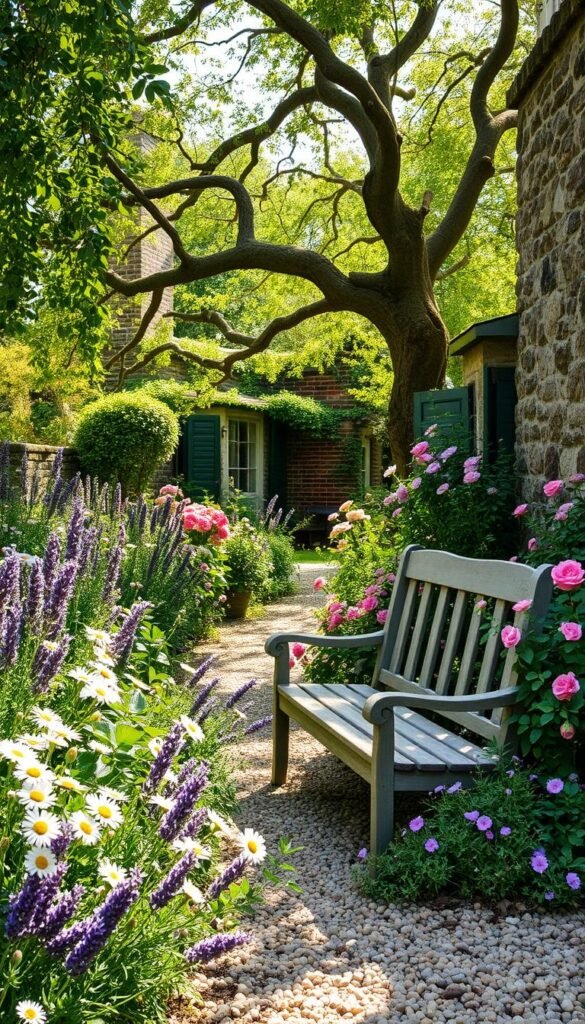
There’s a special magic in spaces that feel both wild and welcoming. Unlike rigid landscapes, these gardens thrive on spontaneity—roses tangling with herbs, daisies nodding beside stone walls. Their appeal lies in how they balance freedom with intention, inviting you to linger rather than just look.
Understanding the Rustic Aesthetic
This style isn’t about perfection. It’s about textures that tell stories: chipped terracotta pots, weathered benches, and gravel paths softened by time. The design philosophy leans into asymmetry, letting plants grow where they please while guiding their spread with subtle borders.
Traditional cottage gardens mix function and flair. Think lavender lining walkways or hollyhocks framing vegetable patches. Materials matter here—rough-hewn wood gates and wrought iron arches add structure without stiffness.
Finding Inspiration in Traditional Designs
Look to history for ideas. Early English plots combined flowers with food crops, creating layered beauty. Today’s approach mirrors this practicality:
| Feature | Cottage Style | Formal Gardens |
|---|---|---|
| Layout | Curving, uneven paths | Straight, symmetrical lines |
| Plants | Mixed heights & species | Uniform hedges |
| Materials | Reclaimed stone, aged wood | Polished marble |
Notice how natural elements create warmth. A bench tucked under climbing vines or a birdbath surrounded by sage—these details turn ordinary corners into poetic retreats. Your space becomes a canvas where beauty blooms through thoughtful imperfection.
Crafting Your Dream Rustic Garden Layout
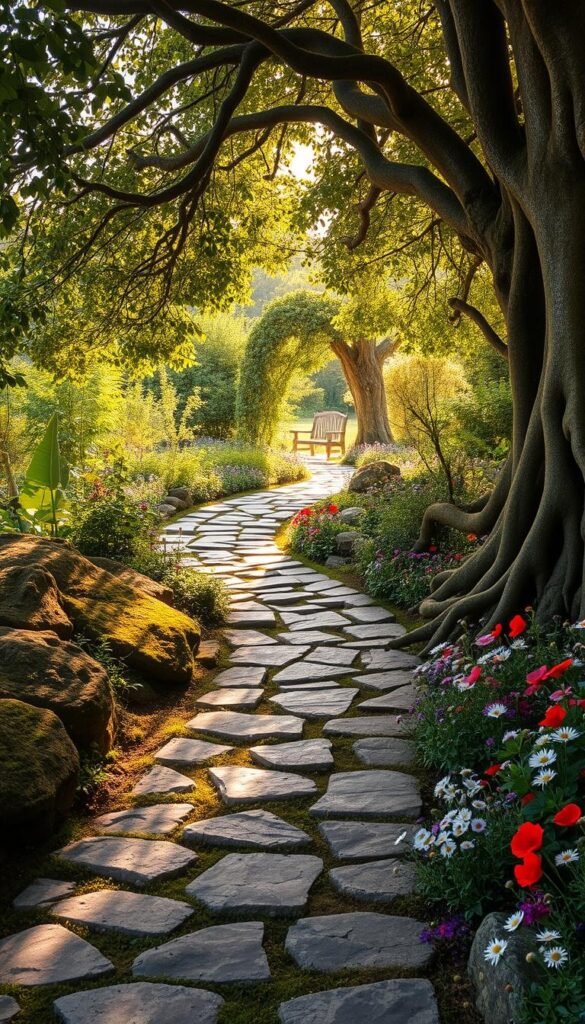
Your backyard holds untapped potential waiting to bloom into a whimsical escape. Start by observing how sunlight dances across your plot—morning rays here, afternoon shade there. Sketching a rough map helps visualize where pathways might curve or where a bench could catch golden hour light.
Evaluating Your Outdoor Spaces
Walk your yard at different times to note sun patterns and soil quirks. Is that corner always damp? Perfect for ferns! Does the west side bake midday? Ideal for drought-tolerant lavender. Jot down existing trees or slopes—they’ll shape your dream outdoor layout naturally.
Consider borrowing ideas from French country styles: curved borders soften edges, making small backyard areas feel expansive. Use graph paper or a free app to draft zones for blooms, herbs, and relaxation nooks.
Planning Winding Pathways and Cozy Seating Areas
Meandering gravel trails invite exploration—space stones unevenly for a lived-in look. Crushed oyster shells add coastal charm, while bark mulch whispers woodland vibes. For seating areas, think beyond patio sets:
- Repurpose an old iron bench under climbing roses
- Nestle Adirondack chairs where evening light glows
- Hang a hammock between mature trees
Position these spots to frame your garden’s best angles. As one landscape designer notes: “A well-placed bench isn’t just furniture—it’s an invitation to pause and breathe.” Blend zones smoothly using low hedges or stepping stones, ensuring each space feels distinct yet connected. For more ideas on elevating your space, consider how textures like weathered wood complement blooming chaos.
Discover the History and Key Elements of Cottage Gardens
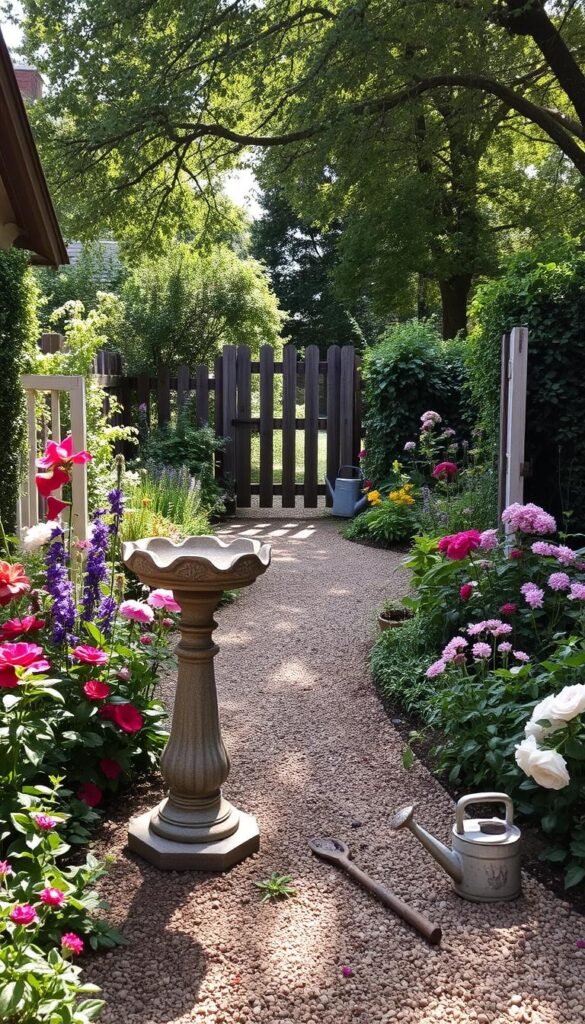
Picture this: medieval villagers gathering herbs between vegetable rows, their plots bursting with color and purpose. What began in 14th-century England as survival gardens has blossomed into a global design movement. These spaces transformed from food sources to living poetry, where practical elements dance with beauty.
From English Roots to Rustic Appeal
Early cottage gardens mixed cabbages with carnations—utility met joy. Peasants maximized small plots, growing medicinal plants alongside edible crops. By the 1800s, these spaces became romantic escapes. Wealthy landowners adopted the wild aesthetic, adding roses and honeysuckle for pure delight.
French country styles later added refinement. Neat hedges framed loose blooms, while symmetrical paths softened into curves. See how traditions blended:
| Feature | Traditional Style | French Influence |
|---|---|---|
| Layout | Chaotic plant mixing | Orderly flower beds |
| Structures | Rustic wood fences | Wrought iron arbors |
| Decor | Repurposed tools | Stone statuary |
Essential Materials and Decorative Accents
Three materials define authenticity: weathered stone paths, reclaimed wood benches, and iron gates speckled with rust. These textures whisper stories of seasons passed. For decorative elements, think beyond store-bought items:
Turn old watering cans into planters. Hang vintage seed packets as wall art. Let moss grow between stepping stones—it’s those imperfect touches that create soul.
Want more ideas? Explore our guide on mixing vintage and modern elements. Whether adding a stone birdbath or iron lanterns, remember: your garden becomes alive when every element feels discovered, not designed.
Incorporate Water Features and Natural Pathways
The gentle murmur of water transforms ordinary spaces into serene escapes. Whether it’s a bubbling fountain or a moss-edged pond, these water features become focal points that soothe the senses. Pair them with winding trails to create an immersive experience where every step feels like a discovery.
Selecting the Right Water Feature
Choose elements that match your space and lifestyle. A birdbath adds whimsy while supporting local wildlife. For smaller areas, wall-mounted fountains save space but still deliver calming sounds. Larger plots might welcome a koi pond surrounded by ferns.
| Type | Maintenance | Best For |
|---|---|---|
| Recirculating Fountain | Low (monthly cleaning) | Compact spaces |
| Wildlife Pond | Moderate (seasonal care) | Biodiversity |
| Stone Basin | Minimal (occasional rinsing) | Vintage appeal |
Using Natural Stones and Tiles for Pathways
Paths guide exploration while adding texture. Irregular flagstones create a timeworn look, while gravel offers crunch underfoot. As landscape artist Clara Bennett notes: “A well-laid trail doesn’t just connect points—it tells your garden’s story.”
| Material | Benefits | Style Match |
|---|---|---|
| Sandstone | Warm hues, slip-resistant | Earth tones |
| Slate Tiles | Modern durability | Structured curves |
| Crushed Shell | Coastal charm | Informal layouts |
Mix materials for visual interest—try brick edging with pea gravel centers. Let moss creep between stones to soften edges naturally.
Selecting the Ideal Plants and Florals
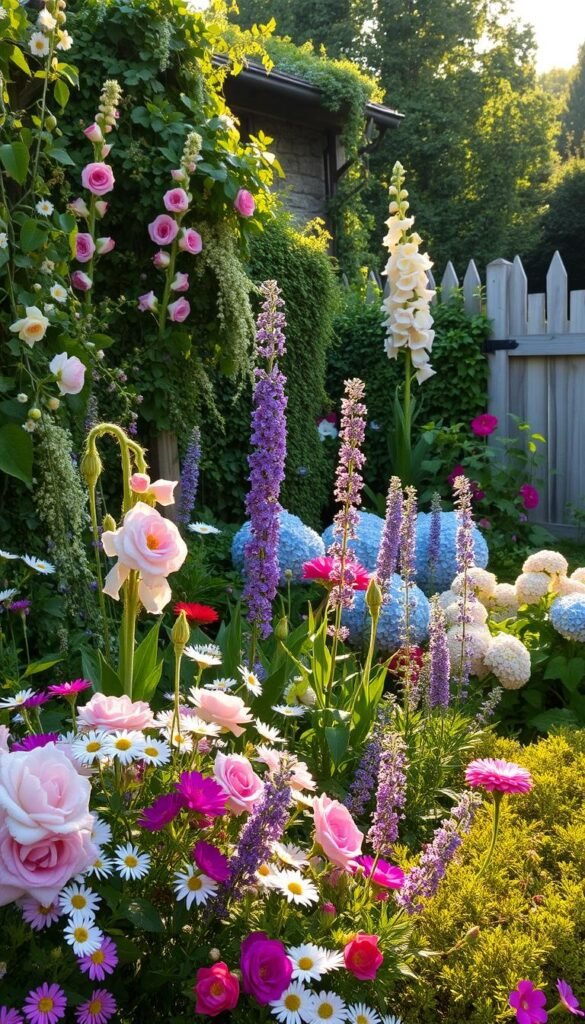
Your plant choices set the stage for a living tapestry that evolves through the seasons. By blending perennials, annuals, and herbs, you create layers of color and purpose. This approach keeps your space vibrant while honoring the practical roots of historical designs.
Mixing Perennials, Annuals, and Herbs
Start with reliable perennials like peonies and lavender—they return yearly, forming your garden’s backbone. Fill gaps with cheerful annuals like cosmos or zinnias for instant summer color. Don’t forget herbs: rosemary and thyme add fragrance and flavor while deterring pests.
| Plant Type | Benefits | Top Varieties |
|---|---|---|
| Perennials | Long-term structure | Foxgloves, Delphiniums |
| Annuals | Seasonal bursts | Sunflowers, Nasturtiums |
| Herbs | Dual-purpose beauty | Sage, Basil |
Achieving Year-Round Color and Texture
Plan for sequential blooms. Early tulips give way to June roses, while autumn sedum adds rusty hues. Combine feathery grasses with velvety lamb’s ear for tactile contrast. As master gardener Elena Carter advises: “Think vertically—tall hollyhocks behind low-growing thyme creates depth.”
For compact spaces, use climbing plants like clematis. They maximize vertical interest without crowding paths. Always match selections to your region’s frost dates and soil pH—native species often thrive with less effort.
Infuse Rustic Decor and Furniture with French Country Influences
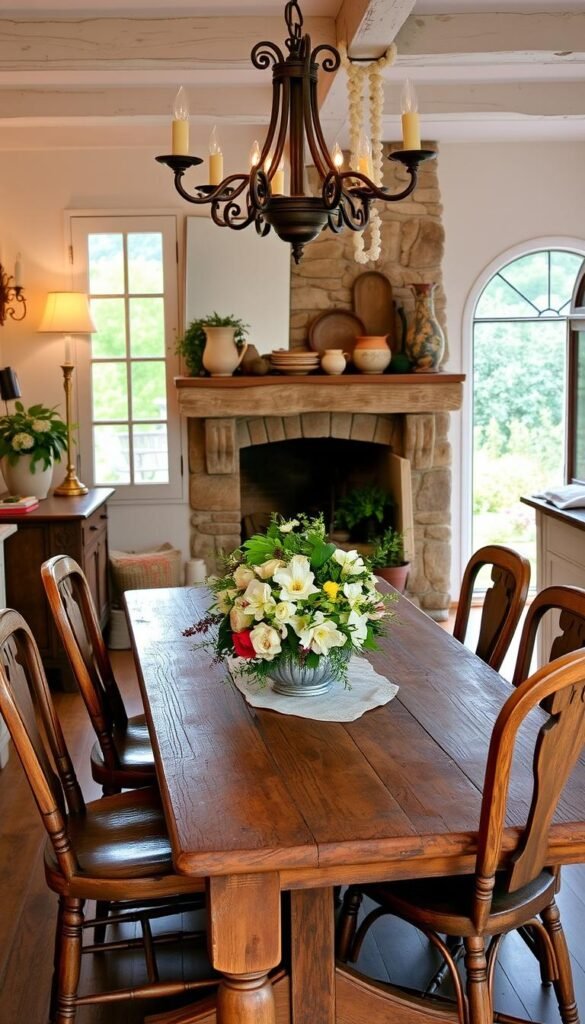
The secret to timeless elegance lies in details that whisper of age-old craftsmanship. French country gardens master this balance, blending weathered textures with practical beauty. Think ironwork kissed by patina and wood softened by decades—elements that turn your backyard into a living scrapbook of curated charm.
Embracing Wrought Iron and Wooden Accents
Wrought iron brings durability and romance to outdoor spaces. Use it for arched gates that frame flower beds or slender plant stands showcasing terracotta pots. Pair these with reclaimed wood benches—their natural grain patterns add warmth while complementing rustic elegance.
Consider these material pairings:
| Iron Features | Wood Pairings |
|---|---|
| Curved balcony railings | Teak dining sets |
| Vine-shaped candle holders | Driftwood side tables |
Incorporating Cozy Outdoor Structures
Pergolas draped in wisteria create shaded retreats perfect for summer lunches. For smaller spaces, try repurposed wooden elements like barrel planters or crate shelves. These structures invite relaxation while supporting climbing roses or morning glories.
Landscape designer Marc Dubois advises: “Let your decorative elements serve dual purposes—a trellis isn’t just for plants, but also a canvas for string lights.” Keep proportions balanced—a massive iron chandelier might overwhelm, while petite lanterns scattered along paths feel just right.
Country Cottage Garden Charm: Creating a Relaxed, Rustic Outdoor Retreat
A truly inviting garden feels like a handwritten note—distinctly yours yet universally welcoming. Start by choosing colors that echo your home’s trim or nearby landscapes. Soft pinks paired with lavender create calm, while golden marigolds add sunny energy. Remember, cohesion comes from repetition—let key hues reappear in flowers, cushions, and garden structures.
Harmonizing Design Elements for a Picturesque Space
Balance abundance with breathing room. Place taller plants like delphiniums behind low-growing thyme, creating depth without crowding. Use vertical features wisely—an arbor draped in clematis draws the eye upward, while a weathered trellis adds structure. As designer Lila Grant advises: “Let one bold element shine, then build around it like supporting actors.”
| Color Scheme | Plant Pairings | Mood Created |
|---|---|---|
| Pastel Tones | Peonies + Catmint | Serene |
| Warm Hues | Sunflowers + Sage | Cheerful |
| Cool Palette | Hydrangeas + Hostas | Calm |
Personalizing Your Garden with Unique Touches
Turn found objects into conversation starters. An antique ladder becomes a plant stand, while hand-painted stones mark herb varieties. These touches make your space feel collected rather than decorated. For seasonal interest, swap decor—pumpkins in fall, twinkle lights in winter—while keeping foundational plants consistent.
Consider texture contrasts: feathery grasses against smooth stones, or rough terracotta beside glossy ivy. These details create layers that invite closer inspection. Your garden becomes a storybook where every chapter reflects your journey.
Maintain and Nurture Your Charming Outdoor Retreat
Nurturing your green sanctuary requires both love and smart strategies. While embracing its wild spirit, a thoughtful approach ensures your plants thrive without losing their carefree beauty. Focus on routines that work with nature’s rhythms rather than against them.
Watering, Pruning, and Seasonal Care Tips
Deep, infrequent watering encourages stronger roots—aim for early mornings to reduce evaporation. Pair this with mulch to lock in moisture and suppress weeds. For budget-friendly irrigation, try soaker hoses or repurposed containers with small drainage holes.
Regular pruning keeps plants healthy and shapely. Snip spent blooms to encourage new flowers, and remove dead branches to improve air flow. In spring, refresh mulch layers and divide overcrowded perennials. Summer calls for vigilant weeding, while fall is ideal for planting bulbs and protecting tender species.
Adapt your care to each season, and your space will reward you with year-round charm. Remember: a little effort goes far in preserving that effortless, lived-in magic.

